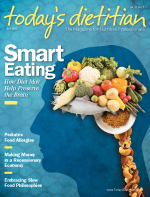July 2009 Issue
Cranberries — Tangy, Tasty, and Nutritious
By Chef Kyle Shadix, MS, RD
Today’s Dietitian
Vol. 11 No. 7 P. 74
The tart taste of cranberries in a lightly sugared scone or a handful of dried cranberries in a bowl of whole grain cereal—delightful. When most of us think of this tasty little fruit, we think of cranberry juice cocktail and its role in preventing urinary tract infections (UTIs). But cranberries may offer even more health benefits than we previously thought.
Packed With Proanthocyanidins
While proanthocyanidins are found in many fruits and vegetables, the type found in cranberries is different. It has a unique structure, and scientists suspect this may be why cranberries have antiadhesion properties that prevent bacteria from adhering to human cells.1 This attribute gives cranberries their good reputation in relation to urinary tract health, since it has been shown to inhibit the adhesion of pathogenic bacteria, such as strains of E. coli that lead to UTIs.1
That Cranberry Smile
Emerging evidence suggests that cranberries may also help protect teeth from bacteria that contribute to cariogenesis. Researchers at the Center for Oral Biology and Eastman Department of Dentistry at the University of Rochester Medical Center evaluated the effect of cranberry juice on dental health and discovered that cranberry juice effectively prevented bacteria from binding to the sites in the mouth associated with cariogenesis.2 Protecting oral health has added advantages, as investigations have begun to uncover links between oral health and cardiovascular disease risk.
Antioxidants in All Forms
Cranberries are known sources of the polyphenolic class of flavonoids. To determine which cranberry products give people the most bang for their buck, University of Scranton researchers assessed the total polyphenol content of a variety of cranberry products.3 They found that the order of total polyphenols on a fresh weight basis, from greatest to least, was dried, frozen, sauce, and jellied sauce. Further discrimination revealed that per serving size, the order of total polyphenols, from greatest to least, was frozen cranberries, 100% cranberry juice, dried cranberries, 27% juice, cranberry sauce, and jellied cranberry sauce.
— Chef Kyle Shadix, MS, RD, is director of Nutrition + Culinary Consultants, an advertising, marketing, and culinary full-service agency in New York City.
Cranberry-Pear Pulled Roasted Chicken Salad
8 servings
Ingredients:
1- to 2-lb whole chicken
1 cup celery, chopped
1⁄2 cup purple onion, finely chopped
1⁄2 cup low-fat or nonfat mayonnaise
1⁄4 cup lemon juice
2 pears, peeled and diced
Zest of one lemon
1 tsp Dijon mustard
2 cups dried cranberries
1 cup chopped walnuts
1 tsp poultry seasoning
1 tsp hot pepper sauce, or to taste
Directions:
Roast chicken to internal temperature of 175˚F, cool, remove skin, and shred the chicken as you pull meat off the bone. Instead of chopping the chicken with a knife, this chicken salad is a new twist on the American classic. Mix together chicken and remaining ingredients in a large bowl until well combined. Cover and refrigerate until ready to serve.
Nutrient Analysis:
Calories: 334
Protein: 19 g
Carbs: 40 g
Total Fat: 12 g
Sat Fat: 1.5 g
Cholesterol: 60 mg
Sodium: 329 mg
Fiber: 5.5 g
References
1. Allison DG, Cronin MA, Hawker J, Freeman S. Influence of cranberry juice on attachment of Escherichia coli to glass. J Basic Microbiol. 2000;40(1):3-6.
2. Koo H, Nino de Guzman P, Schobel BD, Vacca Smith AV, Bowen WH. Influence of cranberry juice on glucan-mediated processes involved in Streptococcus mutans biofilm development. Caries Res. 2006;40(1):20-27.
3. Vinson JA, Bose P, Proch J, Al Karrahat H, Samman N. Cranberries and cranberry products: Powerful in vitro, ex vivo, and in vivo sources of antioxidants. J Agric Food Chem. 2008;56(14):5884-5891.

